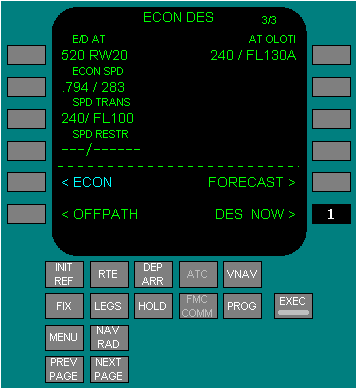Early Descent

An early descent starts when the descent for landing is commenced prior to the FMC calculated top of descent (T/D) point. Early descents should not be started when the distance to the T/D is greater than 50 nautical miles. When further from the top of descent point, the cruise descent function should be used.
Early descents are started on the DES page. Once an early descent is started, VNAV changes to the descent phase and cruise features are no longer available.
The autothrottle adjusts thrust to maintain the target descent rate; pitch maintains the commanded speed. Thrust levers can be manually positioned to adjust the descent rate.
Page Title - The title usually shows ECON during descent. Fixed speed descents modify the title. The page title shows the type of descent:
ECON - speed based on a cost index
LIM SPD - speed based on airplane configuration limiting speed
MCP SPD - MCP speed intervention is selected
XXXKT - fixed CAS descent speed profile
M.XXX - fixed Mach descent speed profile
ACT - prefix shown when descent phase is active
MOD - prefix shown when descent phase is active and the flight plan is modified
Reasons for fixed descent speeds are:
waypoint speed constraints
an altitude constraint associated with a speed constraint
a speed transition
a flight crew entered selected speed (SEL SPD).
E/D AT - Shows the end of descent altitude and waypoint. The end of descent point is a waypoint in the descent phase with the lowest altitude constraint. Blank if no E/D point exists.
ECON SPD or SEL SPD - Shows the current target descent speed.
ECON SPD
economy speed based on cost index
shows CAS or Mach
SEL SPD -
shows when intermediate level off required below an existing speed constraint
shows when flight crew enters speed
CAS or Mach value may be entered.
page title changes to ACT XXXKT DES or ACT M.XXX DES
< ECON prompt appears at line 51- to allow selection of economy descent speed
SPD TRANS - The transition speed is usually 10 knots less than the destination airport limiting speed from the navigation database. When no airport limit speed exists, the default speed of 240 knots is shown. The transition altitude is the point that the transition speed is active for the destination airport. When no altitude exists in the navigation database, the default of 10,000 feet is shown. Blanks when the transition has occurred. Can be deleted.
SPD RESTR - Speed restrictions not associated with specific waypoints are manually entered on this line. Dashes before entry by flight crew. Valid entry is a CAS and altitude (example 240/8000). An entry creates a modification.
ECON - Selects economy descent speed. Blank when economy is the active descent speed.
OFFPATH DES (PEGASUS only) Shows the OFFPATH DES page.
AT XXXXX - Shows the next waypoint constraint from the RTE LEGS page.
Line title shows:
AT XXXXX (the waypoint identifier)
HOLD AT XXXXX
AT VECTORS
AT (INTC).
The constraint is speed/altitude. Blank when no constraint exists. Can be deleted on this page.
VNAV commands the lesser of constraint speed or present performance speed.
FORECAST - Shows the DESCENT FORECAST page.
1 Descend Now (DES NOW)
The DES NOW prompt is shown on the descent page when the cruise phase is active. Reset the MCP altitude and select the DES NOW prompt and execute to start an early descent. The descent page becomes active and the airplane starts a VNAV ECON descent of approximately 1250 feet per minute at ECON descent speed.
Once the descent is established the autothrottle mode changes to THR HOLD to allow the pilot to adjust the rate of descent with power changes.
Upon reaching the planned descent path, VNAV commands pitch to maintain the planned descent path and ECON speed.
Standard | 11.42.36 | Reference Nav Data>
